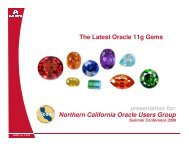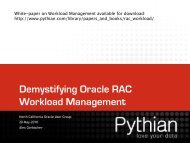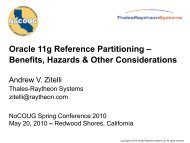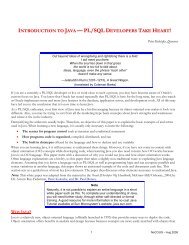Q&A with Juan Loaiza Stay Focused on the Five Steps ... - NoCOUG
Q&A with Juan Loaiza Stay Focused on the Five Steps ... - NoCOUG
Q&A with Juan Loaiza Stay Focused on the Five Steps ... - NoCOUG
You also want an ePaper? Increase the reach of your titles
YUMPU automatically turns print PDFs into web optimized ePapers that Google loves.
“Our competitors have pretty much given up <strong>on</strong> <strong>the</strong> claims that RAC is<br />
flawed and does not work. They have failed to deliver <strong>the</strong>ir muchhyped<br />
sharednothing OLTP architectures. We have even heard that <strong>the</strong>y have given<br />
up <strong>on</strong> shared nothing, and started projects to copy <strong>the</strong> RAC architecture.”<br />
evolving over <strong>the</strong> next decade or two? How is Oracle leading<br />
<strong>the</strong> pack?<br />
I missed Noel’s talk at Openworld so I d<strong>on</strong>’t know exactly<br />
how he is using <strong>the</strong> word “adaptive.” I will give you my perspective<br />
<strong>on</strong> this. The community of database users is extremely<br />
diverse. It includes space scientists, teleph<strong>on</strong>e companies,<br />
governments, web sites, auto makers, financial firms, libraries,<br />
schools, etc. Every <strong>on</strong>e of <strong>the</strong>se communities has interesting<br />
and distinct uses for databases. One of <strong>the</strong> things that we are<br />
working <strong>on</strong> is making <strong>the</strong> database more “adaptive” to <strong>the</strong><br />
special needs of each community.<br />
For example, partiti<strong>on</strong>ing and bitmap indexing technologies<br />
adapt <strong>the</strong> capabilities of <strong>the</strong> database to better meet <strong>the</strong><br />
needs of <strong>the</strong> data warehousing community.<br />
Similarly Secure Files and XML processing technologies<br />
will adapt <strong>the</strong> database to better meet <strong>the</strong> needs <strong>the</strong> unstructured<br />
data communities.<br />
The interesting thing about <strong>the</strong>se technologies is that <strong>the</strong>y<br />
are not really vertical in <strong>the</strong> traditi<strong>on</strong>al sense. For example,<br />
partiti<strong>on</strong>ing was driven by <strong>the</strong> needs of data warehousing, but<br />
it is widely used by many o<strong>the</strong>r communities.<br />
Similarly our XML technologies are coming into widespread<br />
use. Almost every feature that we put in for a specific<br />
community finds use in many o<strong>the</strong>r communities.<br />
We are also adding very sophisticated selfmanaging and<br />
selftuning capabilities that will automatically adapt <strong>the</strong> database<br />
to better meet <strong>the</strong> needs of each individual customer<br />
<str<strong>on</strong>g>with</str<strong>on</strong>g>in a community.<br />
RAC is hot—everybody who’s anybody is eyeing RAC in<br />
2007. RAC has been quite a success story, hasn’t it?<br />
RAC has been extremely successful. When we first introduced<br />
RAC in 2001, we made some very str<strong>on</strong>g claims about<br />
it. We said that <str<strong>on</strong>g>with</str<strong>on</strong>g> RAC you will be able to run off <strong>the</strong> shelf<br />
applicati<strong>on</strong>s in a scaleout envir<strong>on</strong>ment and simultaneously<br />
achieve better performance, higher availability, and lower<br />
cost—<strong>the</strong>se had been c<strong>on</strong>tradictory goals up to that point.<br />
At <strong>the</strong> time, our competitors said that our architecture was<br />
flawed, that our claims were untrue, and that <strong>the</strong>y were going<br />
to roll out sharednothing architectures that would surpass<br />
<strong>the</strong> capabilities of RAC.<br />
<strong>Five</strong> years later we have thousands of customers running<br />
The <strong>NoCOUG</strong> Journal<br />
missi<strong>on</strong>critical applicati<strong>on</strong>s using RAC. The applicati<strong>on</strong>s <strong>the</strong>y<br />
are running include <strong>the</strong> world’s most complex and sophisticated<br />
OLTP applicati<strong>on</strong>s—SAP and <strong>the</strong> Oracle EBusiness<br />
Suite. Some of <strong>the</strong> largest data warehouses in <strong>the</strong> world are<br />
running using RAC. Some of <strong>the</strong> fastestgrowing companies<br />
in <strong>the</strong> world have based <strong>the</strong>ir data architecture <strong>on</strong> RAC.<br />
Our competitors have pretty much given up <strong>on</strong> <strong>the</strong> claims<br />
that RAC is flawed and does not work. They have failed to<br />
deliver <strong>the</strong>ir muchhyped sharednothing OLTP architectures.<br />
We have even heard that <strong>the</strong>y have given up <strong>on</strong> shared nothing<br />
and started projects to copy <strong>the</strong> RAC architecture. When your<br />
competitors endorse your approach, you know for sure that<br />
you are <strong>on</strong>to something.<br />
Most Oracle professi<strong>on</strong>als know you as <strong>the</strong> author of <strong>the</strong><br />
SAME paper. Is SAME still alive and well today?<br />
It’s interesting that I am known for SAME <strong>the</strong>se days. Years<br />
ago I was mostly known as <strong>the</strong> originator of SQL Trace and<br />
TKPROF.<br />
SAME is based <strong>on</strong> <strong>the</strong> basic principle that <strong>the</strong> best way to<br />
optimize <strong>the</strong> performance of your storage is to spread your<br />
load evenly across all <strong>the</strong> disks. This is in c<strong>on</strong>trast to <strong>the</strong> approach<br />
of optimizing <strong>the</strong> performance of each disk drive by<br />
laboriously laying out <strong>the</strong> storage of each table so that <strong>the</strong> I/<br />
Os issued by each query fall optimally <strong>on</strong> each disk and do not<br />
“interfere” <str<strong>on</strong>g>with</str<strong>on</strong>g> each o<strong>the</strong>r.<br />
When I first published this approach, I got a lot of push<br />
back from storage experts that this approach was too simplistic<br />
and would not work in practice. I think over time, many<br />
people have come to understand that by microoptimizing<br />
<strong>the</strong> performance of each table, you are deoptimizing <strong>the</strong> performance<br />
of <strong>the</strong> system as a whole. You are winning <strong>the</strong> battle<br />
and losing <strong>the</strong> war.<br />
The really nice thing about <strong>the</strong> SAME approach is that it<br />
is quite simple to implement, and it keeps working well as <strong>the</strong><br />
applicati<strong>on</strong> evolves and <strong>the</strong> data set changes. In Oracle 10g we<br />
introduced our own volume manager called ASM that incorporates<br />
<strong>the</strong> principles of SAME and makes <strong>the</strong>m trivial to<br />
implement. ASM also solves <strong>the</strong> biggest technical problem<br />
<str<strong>on</strong>g>with</str<strong>on</strong>g> implementing SAME, which was that <strong>on</strong>ce you stripe<br />
your data across your disks, it becomes difficult to add more<br />
disks <str<strong>on</strong>g>with</str<strong>on</strong>g>out relaying out <strong>the</strong> storage from scratch. ▲<br />
<str<strong>on</strong>g>Juan</str<strong>on</strong>g> <str<strong>on</strong>g>Loaiza</str<strong>on</strong>g> will be delivering <strong>the</strong> keynote address at <strong>NoCOUG</strong>’s Winter<br />
C<strong>on</strong>ference <strong>on</strong> February 8 at Oracle Headquarters in Redwood Shores,<br />
and will also participate in a Q&A sessi<strong>on</strong> <str<strong>on</strong>g>with</str<strong>on</strong>g> a panel of top Oracle<br />
developers. Please RSVP at www.nocoug.org/rsvp.html.








